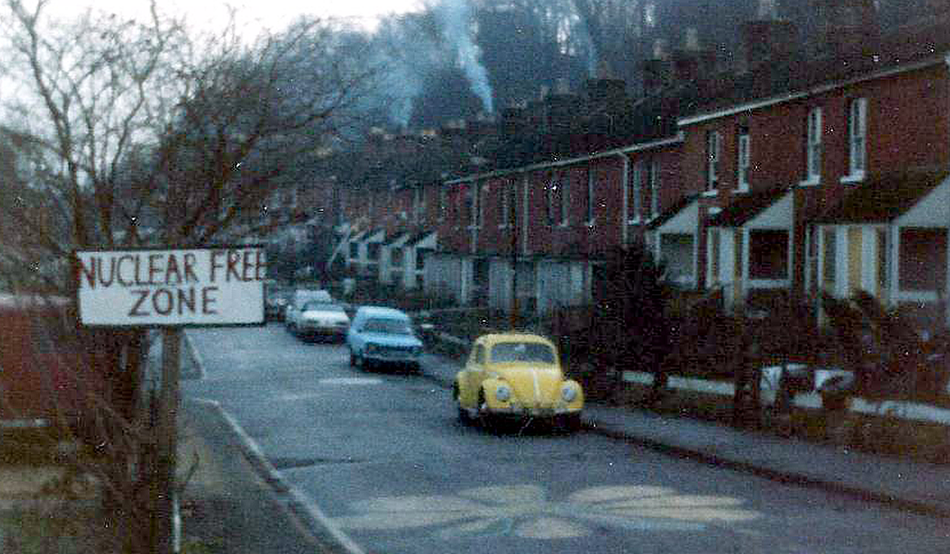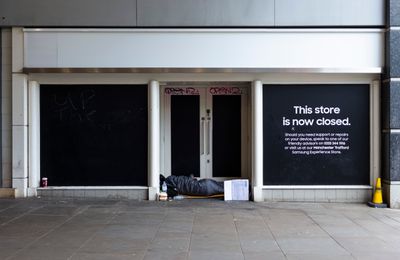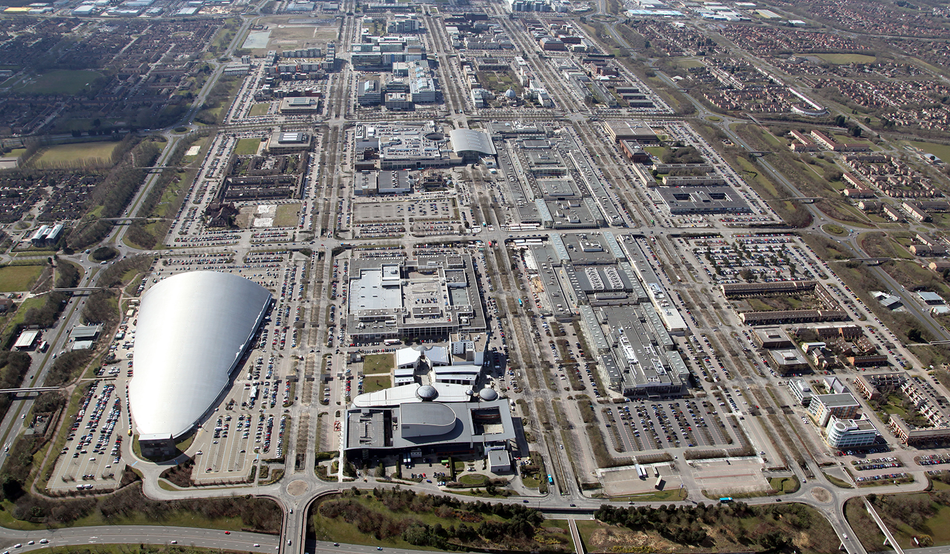Today, Argyle Street is a quiet cul-de-sac, just south of Norwich city centre and a stone’s throw from Norwich City FC’s Carrow Road. At one end lies a block of flats towering over the small road and a collection of new-build bungalows, and at the other, a small patch of grass lined with trees. It’s difficult to believe that in the early 1980s this was home to Argyle Street Alternative Republic, then Europe’s largest squat.
The street was built in 1864 for workers at Colman’s, the condiment manufacturer. By 1963, the 70 houses had been bought by the council-owned Norwich Corporation, which was responsible for urban development. Damp and mould were common complaints, the brickwork was crumbling and the houses were sinking in their foundations. But as huge swathes of the city were being pulled down in slum clearances after the Second World War, Argyle Street was left standing.
The council had begun rehousing most of the tenants but failed to sell the houses to the University of East Anglia, leaving the road largely unoccupied. While councillors dithered over the future of Argyle Street, council leader Len Stevenson spotted an opportunity. In late 1979, he met with some local squatters and activists and suggested that they squat Argyle Street.
Around 40 people moved in one December weekend. A man named Norman and his brother, who were squatting round the corner, moved in first, getting themselves a nice spot at the end of the street, “then I worked my way down the road, opening the houses and people arrived from there” he recalls. For the next five years, the squatters fought the council and government for their right to radically transform their little corner of Norwich.
Gradually, the street collected an eclectic mix of homeless people, middle-class students, Rajneeshees, bikers, anarchists, New Age travellers and a few New Zealanders. Argyle Street Alternative Republic was born—eventually occupying to 60 buildings on the road and housing at least 175 people.
Squatting has a long history in Britain, from the Diggers of the English Civil War to pirate radio, or homeless veterans and their families finding a place to sleep after the Blitz. Squatters get a bad reputation as soap-dodging, violent thieves, stealing the houses of unsuspecting homeowners as they holiday—but the reality however, is that squatters are more likely to transform their squat into a soup kitchen, community centre or homeless shelter. Squats open a window into a different world of collective living, care and autonomy.
“People were often occupying buildings because they needed to house themselves,” says Alexander Vasudevan, Oxford academic and author of The Autonomous City: A History of Urban Squatting, “In the process of doing that, they realise that those spaces could be transformed into something more than just a roof over their heads.”
“The history of squatting… represented that aspiration to imagine a different kind of city that centred ideas of community infrastructure,” he explains.
The people of Argyle Street were no different. Initially the squat fulfilled a very basic need by housing people who simply needed a home. But Eamonn Burgess, who lived there during the five years that the squat existed, explains that “once we had the agreement with Norwich City Council that they weren’t coming in with bulldozers… we went from people just looking after themselves to people that actually wanted to create some sort of alternative society.”
Most people had jobs and repaired the dilapidated houses in their spare time. The street hosted a community centre for meetings and gatherings, painting houses and streetlights so that art filled the road. Less than a month into the squat, a group of feminists picked out a former shop as the home for Norwich’s first women’s centre. In 1980, 23-year-old Marga Suvaal left the Netherlands and soon found herself living in the centre. “Argyle Street changed my life” says Suvaal, “I always thought I was nothing. Through the people I met at the women’s centre, I suddenly realised I wasn’t that stupid and I could do things.”
Together with other feminists in the city, including Booan Temple (who would later become famous for chaining herself to the desk of BBC News to protest Margaret Thatcher’s Section 28 legislation), Suvaal and the women’s centre brought women across Norwich together and provided pregnancy tests, a rape crisis hotline, self-defence classes, childcare, street theatre, trips to Greenham Common, consciousness-raising groups and drop-in advice sessions.
Argyle Street was another act of insubordination against the Conservatives’ housing policy, and the government refused to let it go any further
Through the housing crisis of the 1960s and 1970s, there was an explosion of squatters as families and young people occupied empty buildings. By the 1980s many of these squats had successfully converted to housing associations or cooperatives. Argyle Street followed suit, agreeing a cheap lease for their co-operative, and in 1981 were awarded a grant of up to £1m to redevelop the street and enter a long-term lease with the council.
But this was the era of Margaret Thatcher. In October 1980, council tenants were given the “right to buy” their council houses at a discount, creating a system which viewed housing as a commodity to be bought and sold and laying the foundations for our current housing crisis. Labour councils at the time tried to resist the policy. Michael Heseltine, environment secretary and the man responsible for implementing Right to Buy, singled out the Labour stronghold of Norwich City Council in the House of Commons in 1981, accusing the local authority of obstructing the policy and announcing he would personally intervene to ensure council properties were sold.
Argyle Street was another act of insubordination against the Conservatives’ housing policy, and the government refused to let it go any further. In September 1982, the cooperative read in the papers that Heseltine’s department had blocked the grant and a 45-year lease with the council. There was a change in the air and a sense that the utopia the squatters had tried to build had seen its best days.
The squatters’ dreams of permanently transforming Argyle Street slowly faded away. Building community on that scale was hard work: conflicts needed to be resolved, work divvied up, collective decisions made. Without the promise of secure tenancy, those early squatters began to ask if it was really all worth it.
Mary Newman, who now works in early years education, grew up on the street for a time after her parents separated. Three-year-old Mary and her mum joined a group of Rajneeshees, followers of the Indian mystic Rajneesh, who lived there. Newman still has vivid memories of her time there, “through a child’s eyes, oh it was a lot of fun,” she says. “Everybody wanted to play all the time, there were no rules… there was a lot of freedom, a lot of colour and music.” But over the course of the next few years, the mood would sour.
Vasudevan warns that “squats can be very challenging, precarious spaces. To romanticise them and overlook structural forces shaping houselessness is also very dangerous.” Squatters aren’t exempt from issues like sexual violence and addiction that plague the rest of society. But when everyone expects to be evicted, dealing with harm and conflict can be extremely difficult.
“It really was a community,” says Mary, “but… in any community, there’s always things potentially that you don’t agree with or things that don’t go quite as you planned. My mum and I went away for a while, but when we came back someone had squatted our house and they’d taken all of our stuff and burned all the photos. They were just gone.”
Relations with the council tenants who hadn’t moved out of Argyle Street were rocky. One long-term council tenant on the street complained to the Eastern Daily Press that even “Hitler couldn’t chase people out of this street. I’m fed up and absolutely disgusted.” The squatters had a reputation for being noisy and Argyle Street became more like the wild west than an anarchist utopia. Meanwhile, as Thatcher claimed there was “no such thing as society”, the prime minister ushered in a new era of individualism in which people no longer had responsibility to one another.
“It was all getting a bit gnarly,” says Mary, “the drugs were changing, the people were changing. It became known in Norwich as a famous space where you could do what you want and you can get all the drugs you want. There seemed to be more bikers, more heroin, more speed and so all the fluffy hippies that just wanted to smoked dope and take acid thought ‘this isn’t the place for us anymore; this is over, right?’”
In 1981, the street was used as a set for Memoirs of a Survivor, a film portraying a world after a nuclear apocalypse. The set designers dumped out bags of rubbish to make Argyle Street look more authentic. If they had waited a few more years to film, they could have portrayed Argyle Street as it really was on 20th February 1985, eviction day. The houses were gutted and materials were recycled, sold off or thrown onto a huge bonfire. Some of the few remaining residents had taken to destroying the houses themselves, punching gaping holes through the brickwork with sledgehammers.
In recent years, there have been crackdowns on squatting across the global north.
Last year, Trump railed against squatters’ rights laws as some Republican states passed hostile legislation and now groups of anti-squatter vigilantes exist in the US and Spain.
In England and Wales, squatting residential buildings was made illegal in 2012. At the time, experts and the government’s own advice warned the ban would lead to deaths and increase the number of people sleeping on the streets. Since then, rough sleeping in England has doubled since 2021, from 2,309 to 4,667 in 2024.
Across the UK’s cities, gentrification has bulldozed its way over the wishes of local people, pushing them out in favour of wealthy property developers. Communities are routinely shut out of the decisions that affect them, and while some point to alternative economic models, others prefer a more direct route, taking inspiration from groups like the Argyle Street squatters. The story of places like Argyle Street is one of closing down alternatives to profit-driven modern city life. Despite squats playing important roles in supporting arts and culture and the homeless, they are slowly disappearing, and with them, a completely different way of understanding our cities.
“Any idea that the city could be anything else other than an engine for profit-making is just not on the table” says Vasudevan. Squatting isn’t a silver bullet for all our housing woes, he says, but “in a world where we’re still dealing with the legacy of the move to treat housing as a profit-making machine, holding on to [an alternative] actually is really important.”












